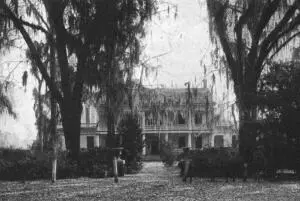CHAPTER II
COLONIAL AGRICULTURE, INDUSTRY, AND COMMERCE
Table of Contents
The Land and the Westward Movement
The Significance of Land Tenure.—The way in which land may be acquired, held, divided among heirs, and bought and sold exercises a deep influence on the life and culture of a people. The feudal and aristocratic societies of Europe were founded on a system of landlordism which was characterized by two distinct features. In the first place, the land was nearly all held in great estates, each owned by a single proprietor. In the second place, every estate was kept intact under the law of primogeniture, which at the death of a lord transferred all his landed property to his eldest son. This prevented the subdivision of estates and the growth of a large body of small farmers or freeholders owning their own land. It made a form of tenantry or servitude inevitable for the mass of those who labored on the land. It also enabled the landlords to maintain themselves in power as a governing class and kept the tenants and laborers subject to their economic and political control. If land tenure was so significant in Europe, it was equally important in the development of America, where practically all the first immigrants were forced by circumstances to derive their livelihood from the soil.
Experiments in Common Tillage.—In the New World, with its broad extent of land awaiting the white man's plow, it was impossible to introduce in its entirety and over the whole area the system of lords and tenants that existed across the sea. So it happened that almost every kind of experiment in land tenure, from communism to feudalism, was tried. In the early days of the Jamestown colony, the land, though owned by the London Company, was tilled in common by the settlers. No man had a separate plot of his own. The motto of the community was: "Labor and share alike." All were supposed to work in the fields and receive an equal share of the produce. At Plymouth, the Pilgrims attempted a similar experiment, laying out the fields in common and distributing the joint produce of their labor with rough equality among the workers.
In both colonies the communistic experiments were failures. Angry at the lazy men in Jamestown who idled their time away and yet expected regular meals, Captain John Smith issued a manifesto: "Everyone that gathereth not every day as much as I do, the next day shall be set beyond the river and forever banished from the fort and live there or starve." Even this terrible threat did not bring a change in production. Not until each man was given a plot of his own to till, not until each gathered the fruits of his own labor, did the colony prosper. In Plymouth, where the communal experiment lasted for five years, the results were similar to those in Virginia, and the system was given up for one of separate fields in which every person could "set corn for his own particular." Some other New England towns, refusing to profit by the experience of their Plymouth neighbor, also made excursions into common ownership and labor, only to abandon the idea and go in for individual ownership of the land. "By degrees it was seen that even the Lord's people could not carry the complicated communist legislation into perfect and wholesome practice."
Feudal Elements in the Colonies—Quit Rents, Manors, and Plantations.—At the other end of the scale were the feudal elements of land tenure found in the proprietary colonies, in the seaboard regions of the South, and to some extent in New York. The proprietor was in fact a powerful feudal lord, owning land granted to him by royal charter. He could retain any part of it for his personal use or dispose of it all in large or small lots. While he generally kept for himself an estate of baronial proportions, it was impossible for him to manage directly any considerable part of the land in his dominion. Consequently he either sold it in parcels for lump sums or granted it to individuals on condition that they make to him an annual payment in money, known as "quit rent." In Maryland, the proprietor sometimes collected as high as £9000 (equal to about $500,000 to-day) in a single year from this source. In Pennsylvania, the quit rents brought a handsome annual tribute into the exchequer of the Penn family. In the royal provinces, the king of England claimed all revenues collected in this form from the land, a sum amounting to £19,000 at the time of the Revolution. The quit rent,—"really a feudal payment from freeholders,"—was thus a material source of income for the crown as well as for the proprietors. Wherever it was laid, however, it proved to be a burden, a source of constant irritation; and it became a formidable item in the long list of grievances which led to the American Revolution.
Something still more like the feudal system of the Old World appeared in the numerous manors or the huge landed estates granted by the crown, the companies, or the proprietors. In the colony of Maryland alone there were sixty manors of three thousand acres each, owned by wealthy men and tilled by tenants holding small plots under certain restrictions of tenure. In New York also there were many manors of wide extent, most of which originated in the days of the Dutch West India Company, when extensive concessions were made to patroons to induce them to bring over settlers. The Van Rensselaer, the Van Cortlandt, and the Livingston manors were so large and populous that each was entitled to send a representative to the provincial legislature. The tenants on the New York manors were in somewhat the same position as serfs on old European estates. They were bound to pay the owner a rent in money and kind; they ground their grain at his mill; and they were subject to his judicial power because he held court and meted out justice, in some instances extending to capital punishment.
The manors of New York or Maryland were, however, of slight consequence as compared with the vast plantations of the Southern seaboard—huge estates, far wider in expanse than many a European barony and tilled by slaves more servile than any feudal tenants. It must not be forgotten that this system of land tenure became the dominant feature of a large section and gave a decided bent to the economic and political life of America.

Southern Plantation Mansion
The Small Freehold.—In the upland regions of the South, however, and throughout most of the North, the drift was against all forms of servitude and tenantry and in the direction of the freehold; that is, the small farm owned outright and tilled by the possessor and his family. This was favored by natural circumstances and the spirit of the immigrants. For one thing, the abundance of land and the scarcity of labor made it impossible for the companies, the proprietors, or the crown to develop over the whole continent a network of vast estates. In many sections, particularly in New England, the climate, the stony soil, the hills, and the narrow valleys conspired to keep the farms within a moderate compass. For another thing, the English, Scotch-Irish, and German peasants, even if they had been tenants in the Old World, did not propose to accept permanent dependency of any kind in the New. If they could not get freeholds, they would not settle at all; thus they forced proprietors and companies to bid for their enterprise by selling land in small lots. So it happened that the freehold of modest proportions became the cherished unit of American farmers. The people who tilled the farms were drawn from every quarter of western Europe; but the freehold system gave a uniform cast to their economic and social life in America.
Читать дальше













